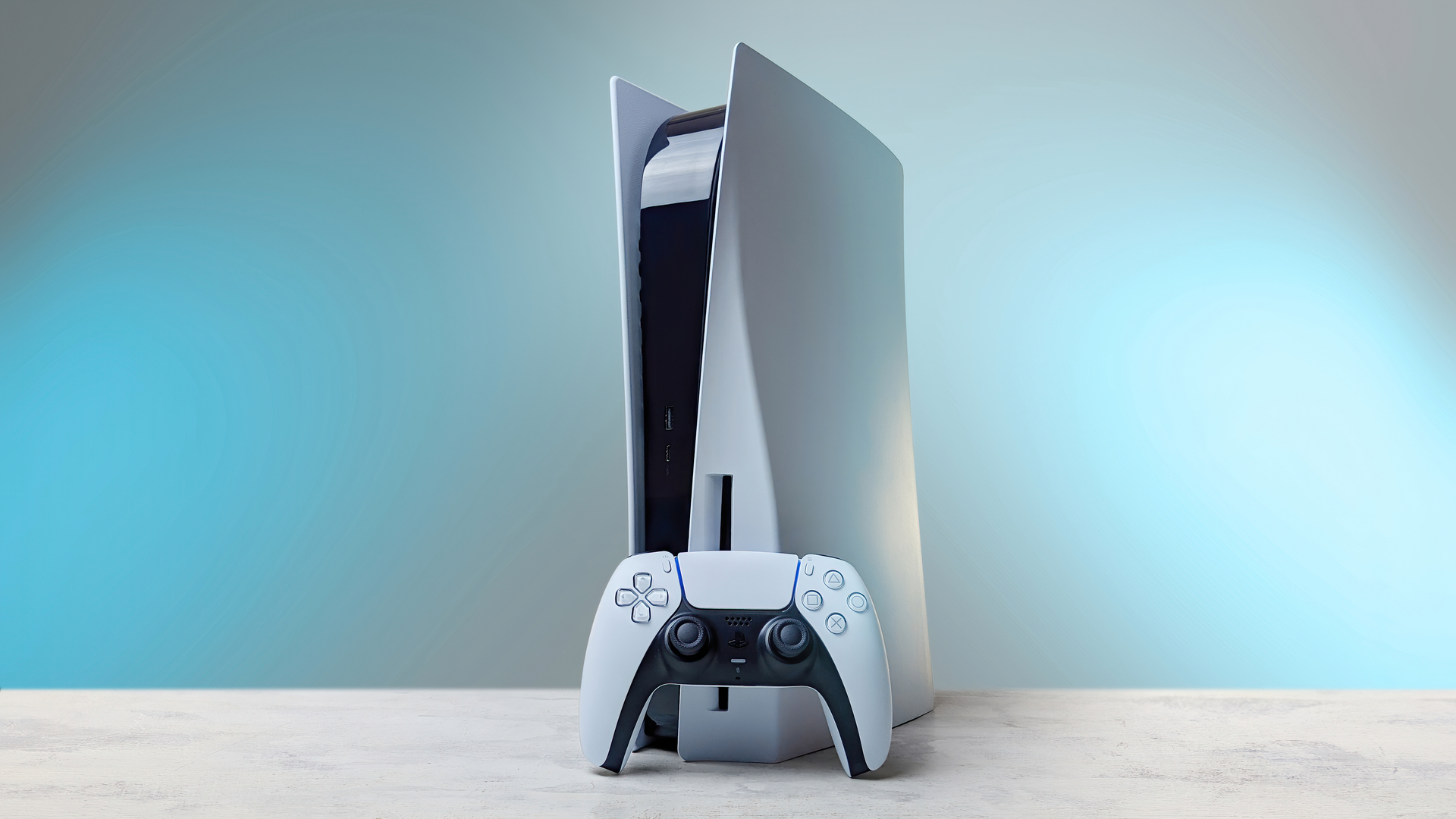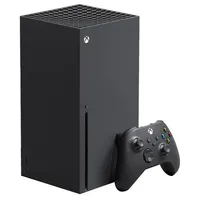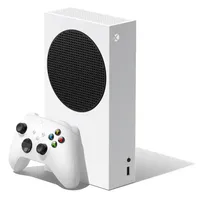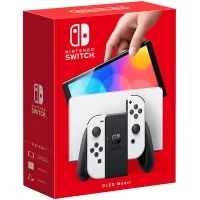TechRadar Verdict
The PS5 is a powerful console offering a sublime current-gen gaming experience. Its library of exclusive games makes fantastic use of the DualSense controller, 3D Audio, and the console's lightning-fast SSD. It might be too big for some setups, though, and a handful of issues hold it back from perfection.
Pros
- +
4K/120fps gameplay
- +
Revolutionary controller haptics
- +
Beautiful, fast UI
- +
Lightning-fast SSD
Cons
- -
Massive size
- -
825GB SSD fills up quick
- -
No Dolby Vision
Why you can trust TechRadar
PS5 two-minute review
The PS5 had some pretty high expectations to match following the success of the PS4, but it's safe to say Sony's current-gen console has massively exceeded every standard set by its predecessor. There's a huge amount to talk about when showcasing what makes the console so impressive, including everything that comes alongside the console itself.
The DualSense controller is nothing short of a revelation with its haptic feedback and adaptive triggers. It's a phenomenally clever bit of tech that, in itself, is a selling point for the console. Sony has also since released an upgraded version, named the DualSense Edge, which would've been equally as impressive as its counterpart if not for the eye-watering price.
With the combination of a fresh UI, rapid SSD-fuelled load times, immersive 3D audio, and incredibly powerful hardware, the PS5 takes some generational strides over the PS4. For these reasons and more, once you've started playing the PS5, it's hard to stop.
But there's no avoiding that the console itself is an eyesore, largely due to its wing-like faceplates and bulky size - although the size has been addressed somewhat with the updated model unofficially known as the PS5 Slim. The plus side to this is that the original PS5's gargantuan size ensures that it's quiet and runs suitably cool. You can still place the console vertically or horizontally, though we really wish it didn't need a stand when on its side. More importantly, we haven't experienced any major hardware issues since launch, like hard crashes or storage corruption.
One area where the PS5 has been slow on the uptake is support for the best 120Hz TVs with HDMI 2.1. However, the games that support 120fps is steadily growing, including first and third-party hits like Horizon Forbidden West, Fortnite and Ghostwire Tokyo.
Equally fantastic is the addition of VRR support to PS5. VRR (or variable refresh rate) keeps the action running smooth on compatible TVs. With PS5 VRR enabled, the console is able to maintain high framerates, without screen tearing, and with little to no hits to overall performance. It's an awesome feature we're very happy to see on PS5.
However, you won't need a top-shelf TV to feel the benefits of the PS5’s substantial horsepower. You can still enjoy unbelievably fast load times, significantly better performance, and a greater level of visual fidelity in new and older games alike.
Sign up for breaking news, reviews, opinion, top tech deals, and more.
From a simpler setup to a well-thought-out user interface, Sony has also re-imagined the key parts of the user experience with some pleasing extras to boot: PS Plus Essential members can enjoy a curated selection of games straight away, while Plus Extra and Premium can access an additional Game Catalog and Classics Catalog. Backward compatibility also ensures that your old collection of the best PS4 games works on day one.
The end result is a console that we're impressed with, which is ultimately strengthened by the PlayStation 5's compelling line-up of exclusive games that continues to grow.
We'd love to have seen more first-party games at launch (there were only four if you include pack-in game Astro's Playroom). It would also have been wonderful to see further support for previous generations of PlayStation titles, like PS2 and PS3. Still, the PlayStation 5 feels like a solid investment and with a growing library of the best PS5 games, we're confident this experience will only improve with age.
The library of compelling titles has certainly grown since the PS5’s release. Returnal takes full advantage of the console’s feature set, Horizon Forbidden West and Gran Turismo 7 both look stunning on the new-gen hardware, while Ratchet and Clank: Rift Apart is a visual spectacle that needs to be seen to be believed.
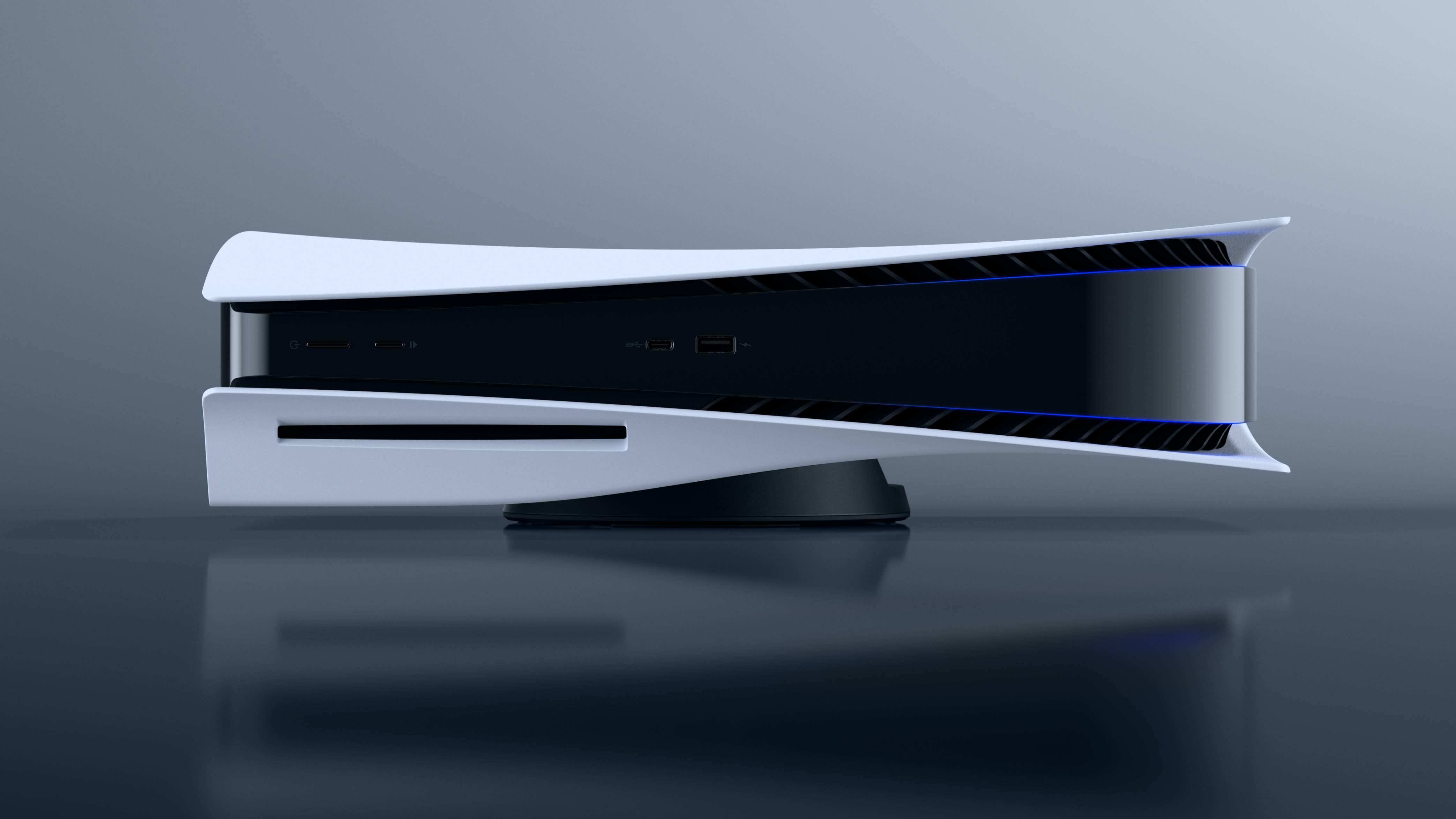
The original, launch-model, of the PS5 - which our review here considers - has now been fully and officially usurped by the PS5 Slim. As of 2025, you can barely find the original model for sale anymore.
This smaller model launched in November 2023 at the same price, but upped the internal storage a little, and swapped one USB-A port for another USB-C port. It still offers the same excellent performance, and you can also swap out the console covers easily, whether you have the disc or digital edition. Read more in our full PS5 Slim review.
The PS5 caters to people ready to jump into the new generation of video games, alongside PS4 owners who don’t want to leave their collection of games behind. It's a console that seamlessly bridges the gap between the last generation and the new, so you probably won't need to boot up your PS4 ever again.
There's big upgrades like the super-fast NVMe SSD and powerful GPU that enable higher frame rates and ray tracing. But you'll also appreciate the subtle touches like the built-in microphone on the controller that can serve as a quick stand-in for a headset. The PS5 feels like it was built for ease of use as well as pure power.
The PS5 Digital Edition is exactly the same as the standard PS5 but removes the 4K Blu-Ray drive to offer a cheaper price point at $399 / £389.99 / AU$649.95 and a more symmetrical look. We've pitted the two PS5 consoles against each other in this PS5 vs PS5 Digital Edition comparison, so you can determine which one is right for you.
Whichever PS5 model you choose, though, we can wholeheartedly recommend the console as a welcome upgrade over the PS4, and an exciting portal to new-gen gameplay. Read on for our full PS5 review.
Watch our PS5 video review below:
PS5 review: price and release date
- PS5 release date: Out now (released on November 12/19, 2020)
- PS5 price: $499.99 / £479.99 / AU$799.95
- PS5 Digital Edition price: $399.99 / £389.99 / AU$649.95
The PS5 was released in North America, Australia, Japan, South Korea, and New Zealand on November 12, 2020. It came two days after the release of Microsoft’s new-gen consoles, the Xbox Series X and Xbox Series S. For the rest of the world, the console became available one week later on November 19.
For the PS5’s price, it originally cost $499.99 / £449.99 / AU$749.95 for the standard version of the console with a 4K Blu-ray disc drive. However, if that’s more than you want to spend, there’s also the PS5 Digital Edition, which is exactly the same apart from the fact it removes the disc drive entirely. At launch, that cost $399.99 / £359.99 / AU$599.95, which is a saving of $100 / £90 / AU$150 over the standard model.
The PS5 is more expensive than the launch price of the PS4, PS4 Slim, and PS4 Pro, which both came in at $399.99, but they arrived seven and four years ago respectively now, and you're getting a generational leap in hardware here for $100 more. The PS5 is still expensive, don't get us wrong, but the jump in price does feel warranted for what you’re getting.
However, much like the Oculus Quest 2, we've seen the PS5 get a price hike with Sony blaming this on soaring inflation globally. The US remains unaffected but that's gone up to £479.99 / €549.99 / AU$799.95 for the standard PS5, and £389.99 / €449.99 / $649.95 for the digital PS5.
Sony isn't the only console maker with new hardware on the block, though – you also have to consider the Xbox Series X/S, which is the closest competitor to Sony’s PlayStation 5. Priced at $499 / £479 / $AU749 and $299 /£249 / $AU499 respectively, this makes PS5 generally more expensive than Microsoft's latest consoles.
We’ve delivered our verdict in their respective reviews linked above, so we won't spend much time talking about them here. But if you’re interested in how these two compare, be sure to check out our PS5 vs Xbox Series X breakdown for more details.
PS5 review: design

- Huge for a modern gaming console
- Space-age aesthetic is polarizing
- But the size means more space for air ventilation and a bigger fan
If gaming consoles had weight classes, the PS5 would be in the heavyweight division. We measured the original to be around 39 x 10.4 x 26cm (H x W x D) – though the curved surfaces make getting an exact measurement difficult. The original PS5 isn’t light, either. It weighs in at 4.5kg, giving it a noticeable heft when you pick it up.
With those measurements in mind, it's easy to see how the PlayStation 5 is the largest console Sony has ever made, and it teeters on the brink of being simply too big for a device that's supposed to sit under your TV. Many will have to rethink their current setup to accommodate Sony's new machine, and that's a problem that no one should have to worry about when picking up a new console.
As for the colors and shape of the console, well, they can be kind of polarizing, too. Some of us on the team absolutely love the PS5 design, while some of us hate the PS5 design. There's no denying, however, that its gargantuan size and two-tone color scheme demands attention in any home. Thankfully, since launch Sony has allowed us to buy new PS5 console covers, each coming in different colors.
One element that's a delightful touch, and universally liked by the TechRadar team, is the system's subtle lighting effect, which creates a soothing hue when the console is in operation or rest mode.
The light strip adds to the PS5's space-age look and feel, and represents a nice touch of continuity from the PS4. Much like the PlayStation 4, when the console is in rest mode the light turns orange, and when the PS5 is turned on it changes from blue to white.

We’re a bit bemused by Sony's choice to put glossy plastic down the center spine of the console, though, particularly as that's where the front USB ports are located. After over three years of use, we can confirm that the plastic can become scratched over time, even though we were extremely careful when plugging in any devices into the front of the console.
We were worried that this might be the case when we first reviewed the PS5, and we’re kind of surprised that Sony didn’t contemplate this happening during development. The glossy finish is also a big dust and fingerprint magnet, which makes the choice all the more bewildering. Thankfully, it's relatively easy to clean your PS5.
Due to its curves and tall stature, it's not just a case of placing the console down and playing once you pull the PS5 out the box. You'll need to wrap your head around the PS5's attachable stand first, which isn’t exactly the most user-friendly experience.
The console can't be placed horizontally without the PS5’s stand, and you risk impeding airflow if you don't use it when the PS5 is standing vertically.
The stand, while functional, feels slightly cheap in the hand too. It has a small compartment to hold one lone screw (don’t lose this, as you'll need it when placing the console vertically) and at first glance, it doesn't look like the setup will actually work when laying the console flat.
To its credit, though, it does the job in a no-thrills fashion – however, we found the stand slipped off the small lip that it clamps onto multiple times when we shifted our unit into position.
In terms of ports, the front of the PlayStation 5 has a USB-A and USB-C port, while the back sports two USB-A ports, a HDMI 2.1 port, an Ethernet port and a power port. There are no proprietary ports on the console, which is always a bonus if you need to replace the odd cable.
PS5 review: performance
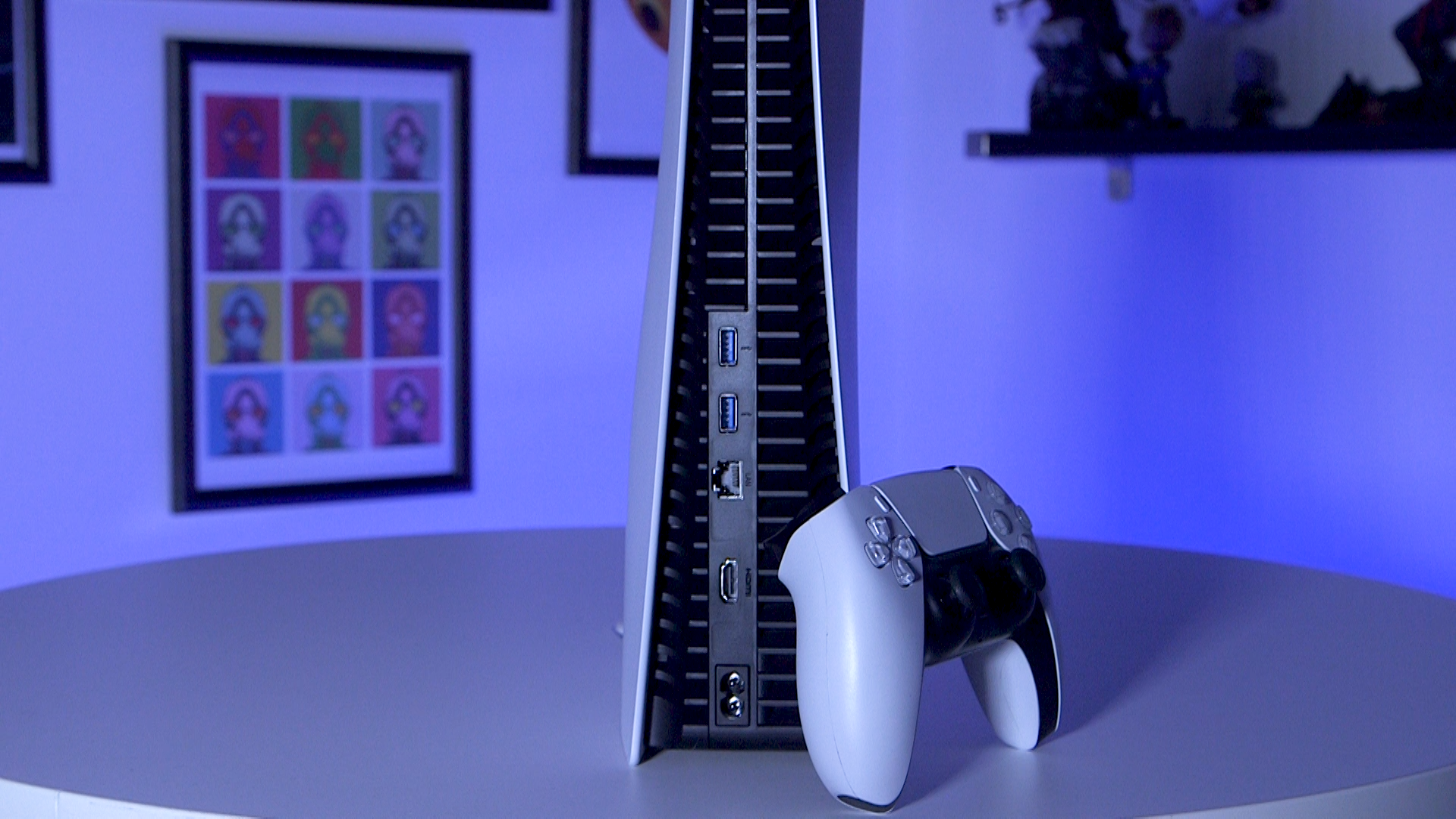
- Capable of 4K/120fps gameplay as well as support for 8K/60
- Faster loading times thanks to new SSD
- System runs cool and quiet nearly all the time
When it comes to specs, the PS5 is a technically impressive piece of hardware. There's the new custom RDNA 2 GPU that can push 4K resolution at 120 frames per second, and the octa-core AMD Zen 2-based CPU with a 3.5GHz clock speed.
Throw in 16GB of GDDR6 memory and a 825GB NVMe SSD, and this is a machine with some seriously impressive specs. The PS5 is also capable of outputting 8K resolution, however, we'll need to wait for a firmware update from Sony before it's able to do so.
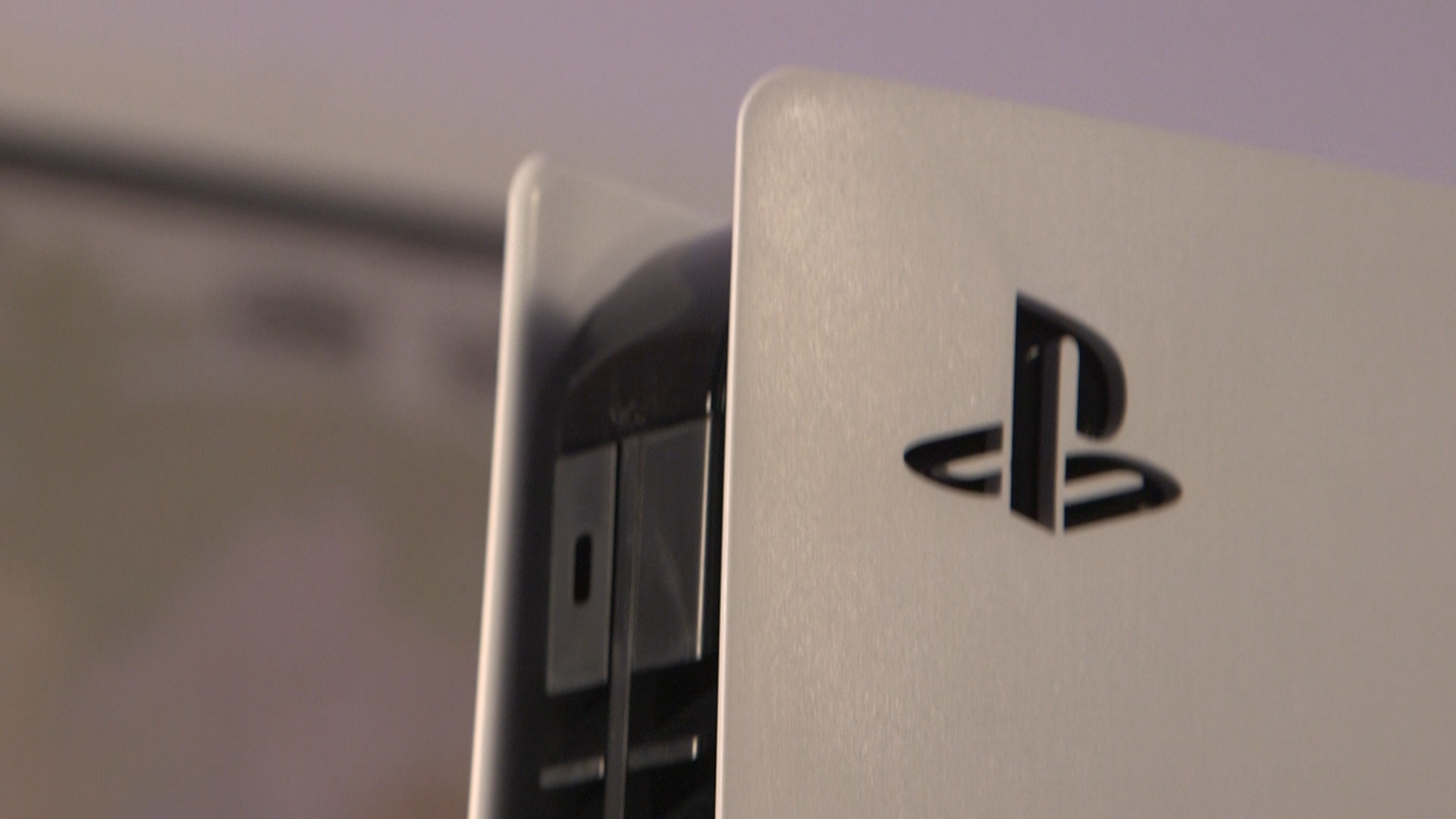
CPU: AMD Zen 2-based CPU with 8 cores at 3.5GHz (variable frequency)
GPU: 10.28 TFLOPs, 36 CUs at 2.23GHz (variable frequency)
GPU architecture: Custom RDNA 2
Memory interface: 16GB GDDR6 / 256-bit
Memory bandwidth: 448GB/s
Internal storage: Custom 825GB SSD
Usable storage: 667.2GB
IO throughput: 5.5GB/s (raw), typical 8-9GB/s (compressed)
Expandable storage: NVMe SSD slot
External storage: USB HDD support (PS4 games only)
Optical drive: 4K UHD Blu-ray drive
In fact, the only real issue we have with the PlayStation 5's spec sheet is the amount of storage available. It's only using an 825GB SSD instead of, say, a 1TB or 2TB SSD. That decision was clearly made to cut down on the cost of the console, but it means that you can run out of storage quickly if you're not being judicious about which games you keep installed.
The console comes with 667.2GB of usable storage, which we found held around 16 games: two PS5 titles, which were Astro's Playroom and Marvel's Spider-Man: Miles Morales, and various PS4 games like God of War and Detroit: Beyond Human. The available space actually went further than we thought, although your mileage will vary depending on the size of the games you have installed.
It may have taken over eight months after launch, but it's now possible to upgrade the internal storage with an NVMe SSD. You can pop off the PS5's plastic faceplates to reveal the empty SSD bay and secure a compatible M.2 SSD in place using a screwdriver. We've rounded up the best SSD for PS5 and created a detailed guide showing you how to upgrade your PS5 internal SSD storage.
Adding more storage via the SSD bay isn't the most intuitive of methods, and feels like a slight oversight on Sony's part - but hopefully, it's only something you'll need to do once. It’s also handy that you'll at least be adding storage onto the existing 667GB, instead of starting from scratch.
The good news is that you're also able to use external hard drives and SSDs by plugging them into the USB port. You won't experience the same lightning-fast load times that you get from the built-in SSD and optional (not to mention locked) SSD bay. But if you use an external SSD, you'll still see a massive boost to load time performance over a regular mechanical hard drive.
We plugged in an external SSD into one of the PS5's USB ports and the process of getting things set up was effortless. The console detected that an external drive had been connected, and once it was formatted, we were able to store and transfer PS4 games to it. After a PS5 system update in April 2021, you can now also store PS5 games or save data to external storage. However, you’ll need to transfer games back onto the internal drive if you wish to play them.

While few of the launch games really gave the new hardware a run for its money, we can already see the potential in Sony's upgraded hardware. Crucially, more titles designed with PS5 specifically in mind are on the way.
Load times are where most new PS5 users will see a stark difference, to begin with. In Marvel's Spider-Man Remastered, for example, load times have gone from 15-20 seconds on the PS4 to less than a second on the PS5, and Demon’s Souls takes literally seconds to load entire, sprawling levels. Returnal is another game that benefits greatly from the PS5’s super-fast SSD, with not a load screen in sight as you traverse countless biomes.
Graphical improvements, particularly when it comes to resolution, are the next immediate highlights when it comes to playing on PS5. Astro's Playroom runs at a rock-solid 60 frames per second at a 4K resolution, and almost every title we’ve played is either playable at 60fps by default or provides a 30fps mode with more visual flourishes. It's a dramatic and pleasing shift from the PS4, where games were often 1080p / 30fps.
In the future, more titles will run 4K resolutions at 120 frames per second, too, and there's the potential that less graphically intensive games could reach 8K/60fps. For now, though, we don't expect many games to hit that ambitious target (most will drop the resolution from 4K to achieve a higher frame rate), but there's a chance some titles will be able to achieve that coveted 4K/120fps output down the line.
A small slice of the PS5 launch library supported 120fps, and included Call of Duty: Black Ops Cold War, Devil May Cry V: Special Edition, Dirt 5, Rainbow Six Siege and WRC 9. It's worth noting that you'll need a HDMI 2.1-compliant TV to display the 120Hz refresh rate at higher than 1080p resolution. Here's how to enable 120Hz on PS5.
Unfortunately, we haven’t seen as many 120fps enabled games as we’d hoped since the PS5 launched. Still, things are slowly improving, though you'll find far more 120fps games on Xbox Series X|S.
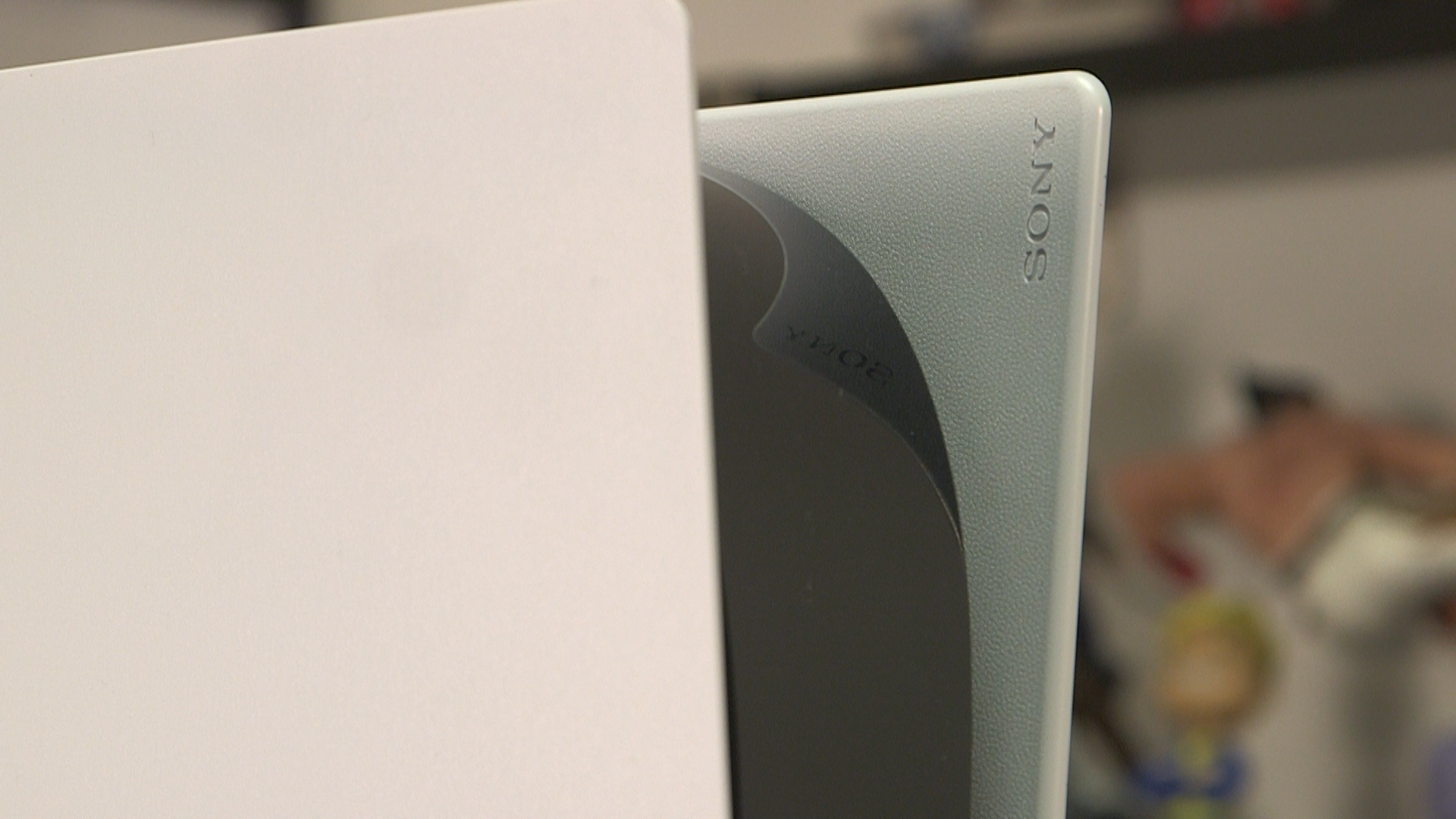
So what can you expect if you pick up a PS5 today? For now at least, most games will be capable of delivering 4K resolution at 30fps or 60fps when using a game's Performance Mode (which we'll explain below). Many will also utilize 4K image assets for crisper textures, while HDR support helps to provide better colors and contrast.
Combine that with ray tracing and improved particle effects that are now possible with the current suite of development tools. Games look leaps and bounds better now than they did a decade ago.
Even though not every PS5 launch game will have it, most should feature the aforementioned Performance Mode, which prioritizes higher frame rates over resolution and extra graphical features. With many games, this sacrifices various graphically-intensive effects like ray tracing or higher shadow quality, and drops the base resolution, in order to achieve higher frame rates like 60fps instead of 30fps.
But why would you want the extra frames at the expense of resolution? Well, higher frame rates make games feel far more responsive – which is a must for first-person shooters that require twitch-based reflexes and split-second decisions.
For some gamers, higher frame rates are the holy grail for consoles – something that has been hard to achieve for decades due to weaker hardware. To have this finally be an obtainable goal feels like a monumental achievement, even if it comes at the cost of some graphical flourishes.
If you'd prefer not to use Performance Mode, you can always choose Resolution Mode. This prioritizes higher resolutions, better rendering techniques like ray tracing, and more detailed graphics. We got a taste of that with Marvel's Spider-Man: Miles Morales, and we loved what we saw. Lighting was improved substantially: windows glistened in the sunlight and contained realistic reflections, and the particle effects looked stunning.
What you can expect from this new generation of gaming, then, is faster load times, better framerates in Performance Mode, and higher target resolutions everywhere else. Simply choose which option you prefer.

How good is PS5's 3D Tempest Audio?
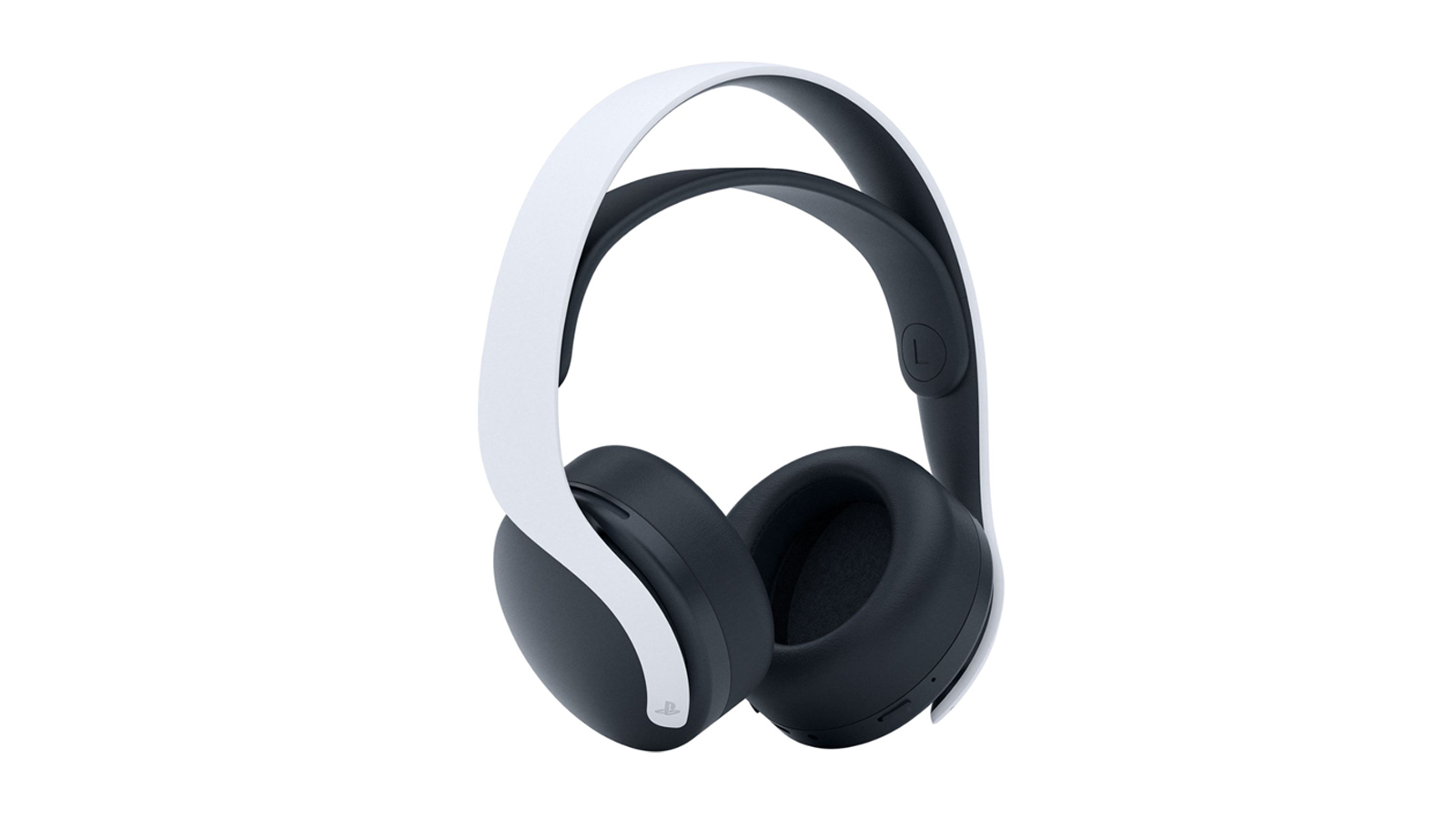
If you head into the PS5 settings, you can adjust the 3D audio to suit your preference. There are five levels of height to choose from, so select the option that sounds closest to your ear level. Remember that 3D audio works on any headset, either wirelessly or when plugged into the DualSense controller, and can also be enabled using your TV speakers.
The PS5's 3D Tempest Audio is Sony's take on Dolby Atmos, or spatial audio in general. It works on any headset, with 3D audio support for TV speakers now available thanks to a recent update.
We've tested various spatial audio solutions in the past, ranging from Windows Sonic to Dolby Atmos, and we've found that PS5's 3D Audio is a comparable experience overall, though it isn’t quite the revelation we hoped it might be.
We enjoyed hearing ships fly past and over our head in Astro's Playroom, and appreciated being able to pick out thugs that were closing in on us in Marvel's Spider-Man: Miles Morales. It's not as detailed or as realistic as Sony made out, though, at least not at this stage, and it will be up to developers to get the most out of the technology as it matures.
Returnal has shown that 3D audio can be a powerful tool when it comes to increasing immersion and that it can also be beneficial in fast-paced games where audio cues are just as important as what you see on screen.
It’s the best implementation of the technology yet, and we hope Sony continues to support it. Right now, these are the best PS5 headsets for 3D audio. You can expect to experience Tempest 3D audio in all of Sony's first-party titles, like Sackboy: A Big Adventure.
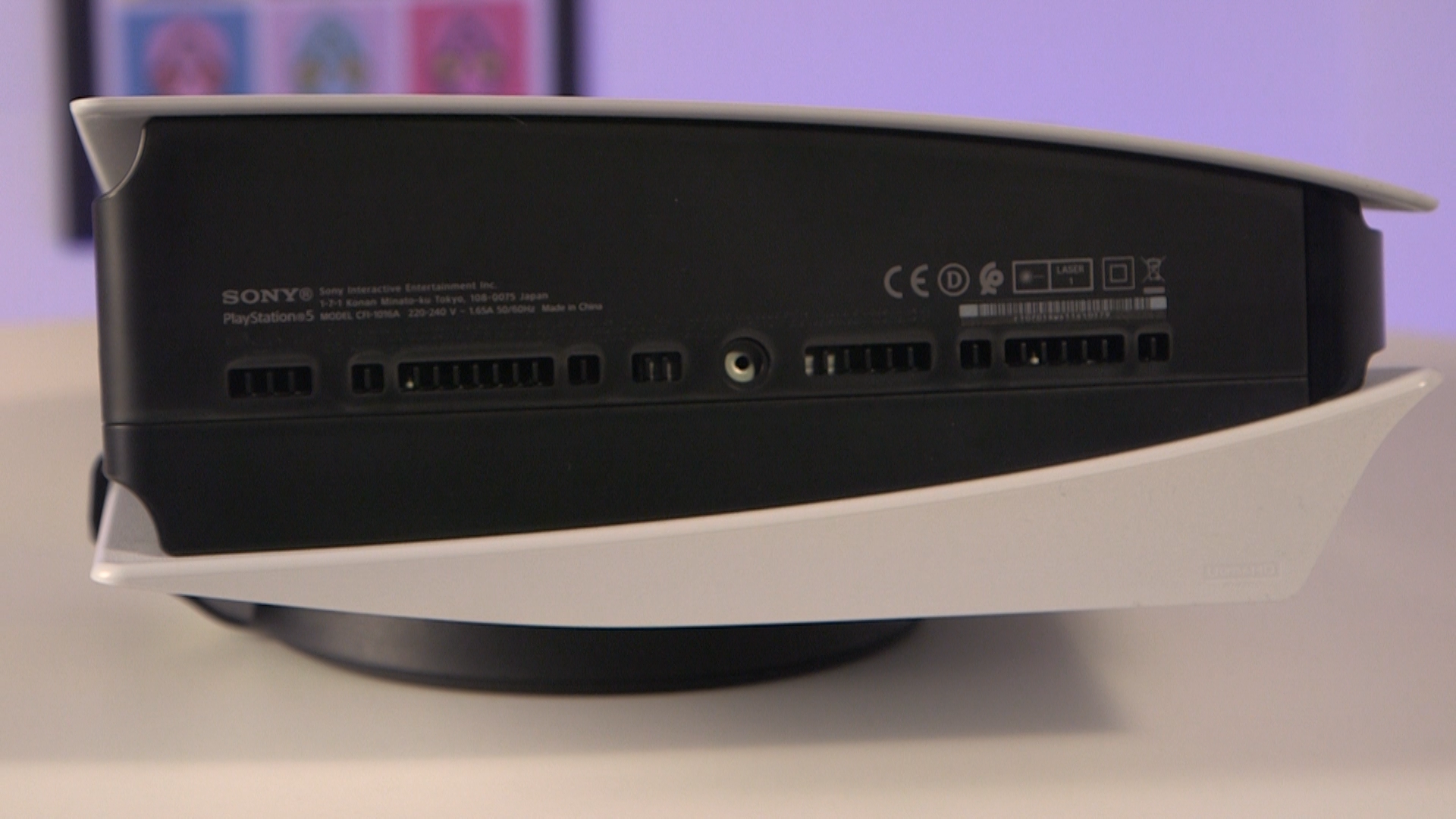
What about heat and noise?
The PS5's monstrous footprint gives it one significant advantage over its predecessor in that the console is basically silent – and heat production is also minimal. We have noticed a bit of coil whine on some units, which is where the console emits a faint electrical noise during certain games, but compared to PS4 it’s a monumental improvement.
The PS4 and PS4 Pro were renowned for their ability to kick up the system fans to obnoxious levels and output lots of heat, particularly on the earlier models, so those looking to pick up a PS5 will be relieved to hear that those problems have been eradicated.
We held our hand near the system during a long play session, and although the PlayStation 5 was clearly outputting hot air (as it's designed to do) it was emitting far less than what the PS4 Pro would push out.
Very rarely in our testing did the fans reach an audibly loud level to the degree that the PS4 Pro did when running games like Horizon: Zero Dawn or God of War. However, that could simply be due to the fact that at the time of testing, we hadn't seen any resource-heavy PS5 games yet. Sony has also promised that it plans to optimize the PS5's fans using over-the-air updates, so the machine could get louder, or indeed quieter, when playing certain games later down the line.
PS5 review: DualSense controller
- New DualSense Controller feels like a revolution over the DualShock 4
- Highlights are the adaptive triggers and haptic feedback
- Mute button can mute your mic or, if your TV has HDMI CEC, your TV

To navigate this brave new world of console gaming, you'll need a new gamepad – namely, the new Sony DualSense controller.
You'll be pleased to hear that you get a DualSense controller in the box with your PS5, and the DualSense feels oddly similar in the hand to the DualShock 4 that shipped with the PS4. We found it to be incredibly comfortable to hold for extended periods, and were shocked that when we went back to our trusty DualShock 4, it felt plain wrong to hold after using the DualSense.
Picking it up for the first time, the DualSense is fairly weighty and balanced, with most of the heft resting in the grips of the controller. While the majority of the controller features a matte white plastic finish, the bottoms of the grips themselves have a slightly rougher texture that actually makes the controller easier to hold, and less likely to slip out of your hands.
In fact, if you look closely, the texture is made up of tiny PlayStation face buttons, which is a neat little touch. The two-tone PS5 controller color scheme extends to the four face buttons, which still consist of the classic Triangle, Circle, Square and Cross (or X); however these are now devoid of color, and remind us of the PS Vita's minimalist approach.
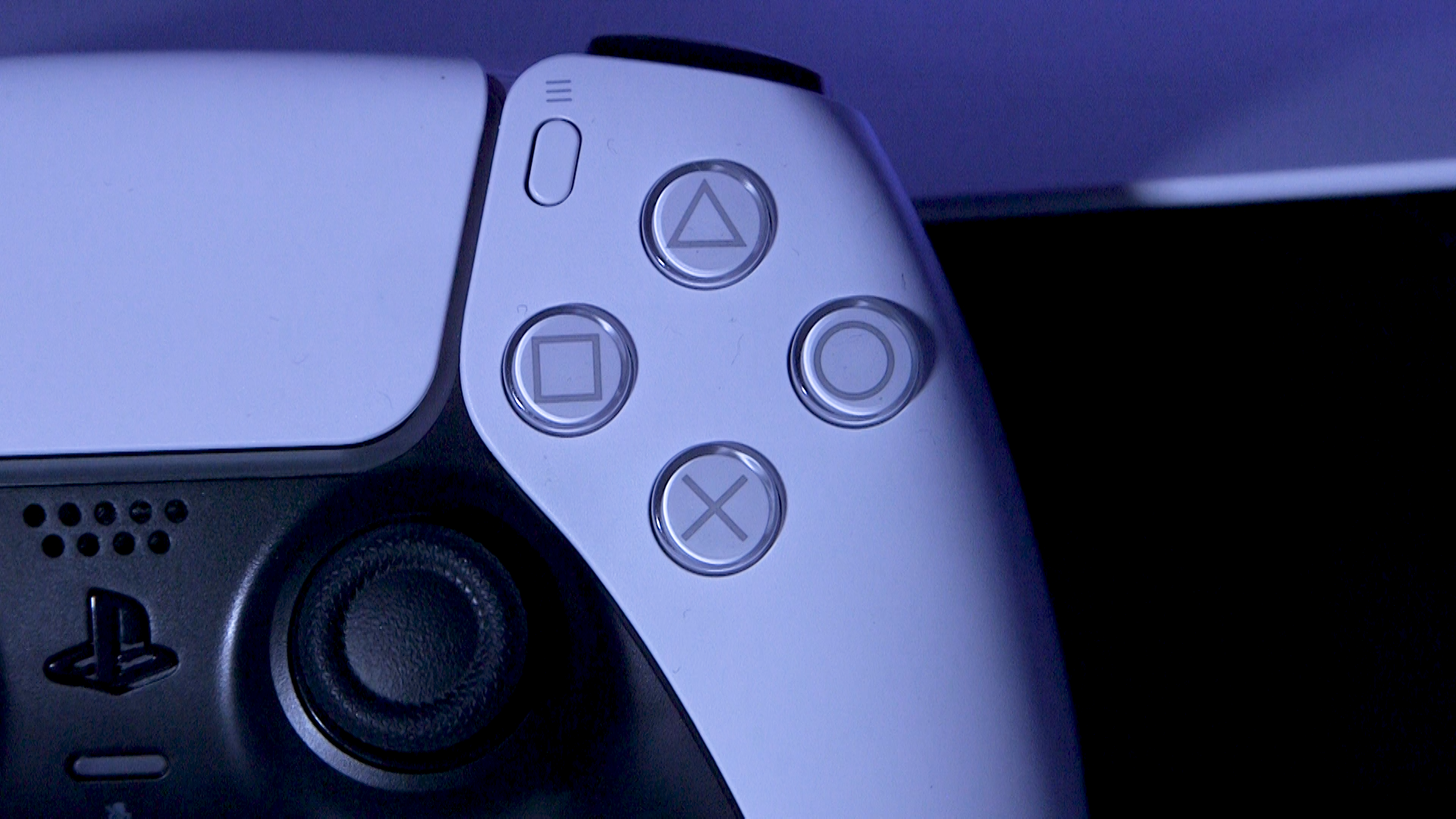
There's a pop of color around the side of the central touchpad, though, as the PS4 Lightbar has thankfully been moved from the top of the gamepad to a less problematic position – thanks to its new placement, you won't now see an annoying glow reflecting off your TV.
Where early PlayStation controllers sported a convex analog design, the PS5 DualSense controller has concave control sticks, just like the DualShock 4, and they feel noticeably more durable this time around, with a pleasing textured finish on the outer ridge.
On early models of the PS4 the rubber analog sticks would sometimes wear away under vigorous gameplay sessions, and we’re pleased to report that even after six months of use, we haven't seen it reoccur with the DualSense. You'll notice a few new buttons you haven't seen before on Sony's new pad, too – like the mute button that turns off the microphone that’s built into the controller.
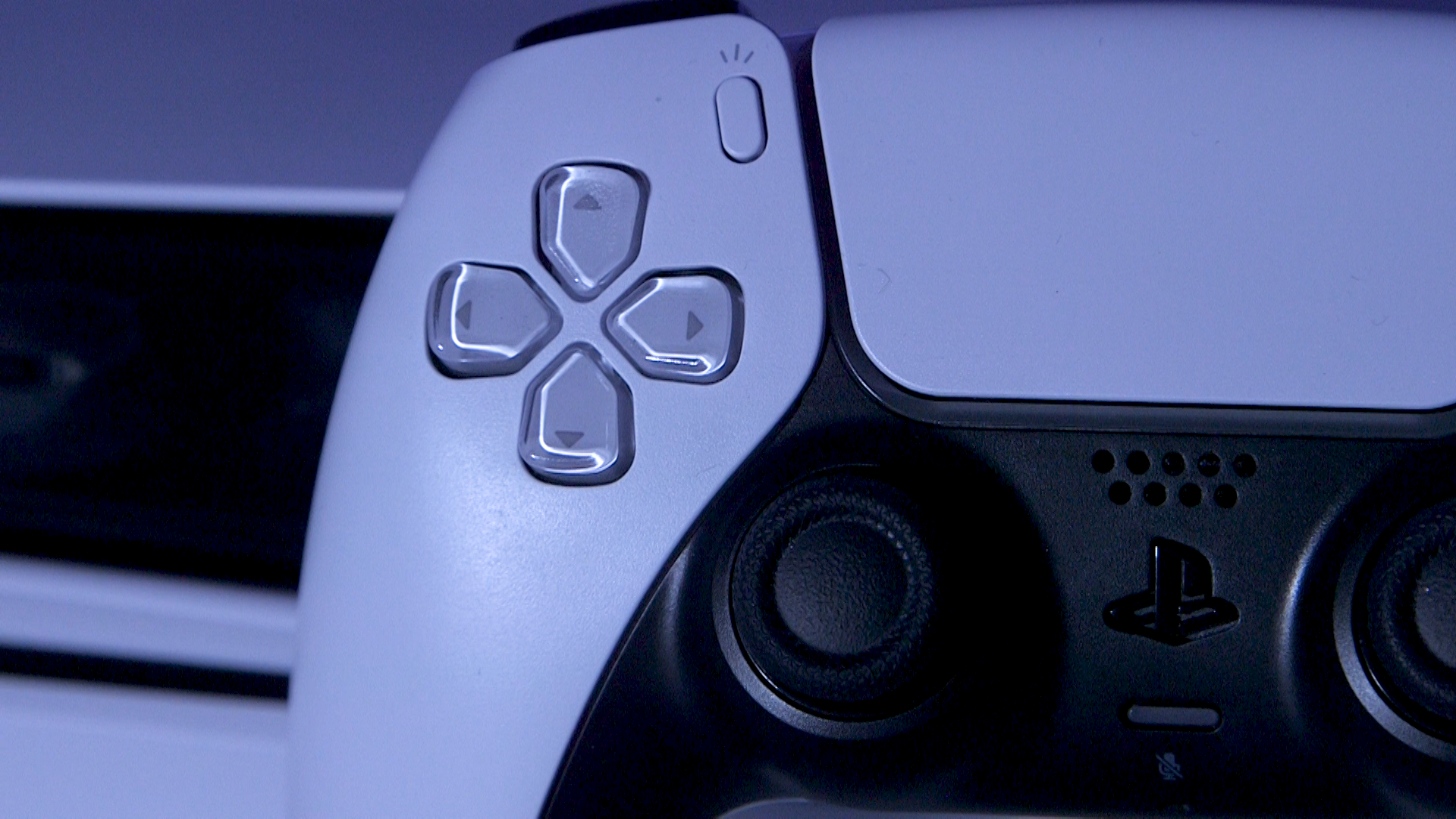
When this is held down, it can mute your television speakers or headset, which we found to be a useful quality-of-life feature. When speaking into the mic, we found it worked best when we kept the controller in our usual playing position, instead of holding it towards our mouth. We wouldn’t recommend using the DualSense microphone for voice chat, though – it isn’t the highest quality and has a tendency to pick up a lot of environmental sounds.
The highlights of the new DualSense controller, however, are the adaptive trigger buttons that allow developers to add resistance to certain in-game actions. The adaptive triggers can use resistance to create various sensations that mimic real-life actions, like pushing down on the pedal of a car or pulling back a bow string.
It's a huge step forward for haptics in Sony's hardware, and we found that the haptic feedback itself is a vastly superior replacement for the traditional rumble of old. When a character runs across a certain surface, like metal, it manages somehow to replicate that feeling in the palms of your hands – it's a truly wonderful sensation.
So far, we've seen a variation of haptic feedback support integrated into every PS5 game we've played so far, and hope to see it supported by more games in the future; we expect the feature to shine most in first-party titles, though. Returnal uses the DualSense to great effect, mimicking the effect of rainfall using haptic feedback, and the trigger performing two fire types by pressing it either halfway or all the way down.
Accessibility shouldn't be a concern either, as the adaptive triggers and haptic feedback can be turned off at system level, or adjusted to suit your needs. You can learn how to turn off the DualSense adaptive triggers and haptic feedback here. You can also use a PS5 DualSense controller on PC.

Battery life, so far, has been a massive improvement over the DualShock 4. We played through a handful of PS5 and PS4 titles during our testing, including Marvel's Spider-Man: Miles Morales and Astro's Playroom, and the controller eventually ran out of charge after 12 hours and 30 minutes. This will obviously vary depending on the types of games you’re playing and how much they use the DualSense’s features, of course, so that 12 hour figure could end up a lot lower.
Still, it's an impressive feat when you consider the DualShock 4 lasted around five to eight hours at a stretch. While internal batteries can degrade over time, it's a strong start for Sony's new pad, particularly when you consider how much technology is packed into it. Of course, you can also use the controller wired if you prefer.
To charge the DualSense, you have two options: either connect it to the PlayStation 5 itself with the USB-C to USB-A cable that comes inside the box, or shell out for the optional PS5 DualSense Charging Station, which can charge two controllers at a time using the metal conduits on the bottom of the pad near the 3.5mm audio jack.
You can also charge the controller, or your USB headset, via the rear USB ports, or opt to use a USB-C to USB-C cable when using the front USB-C port to charge the DualSense controller.
Either option works well, but the Charging Station does certainly look nicer sitting on the shelf, and more cost-effective third-party charging stations will likely become available in the coming months. We'll also need to test whether charging the controller via a USB-C to USB-C cable is quicker than using the USB-C to USB-A cable that comes with the console.
Still, if that doesn't sound entirely appealing, there's always the recently announced DualSense Edge, Sony's rival to the Xbox Elite Wireless Controller and the Xbox Elite Wireless Controller Series 2. Presenting a more premium build with customizable options and bespoke features, we don't have a release date just yet for this, but we'll keep this updated once we know more.
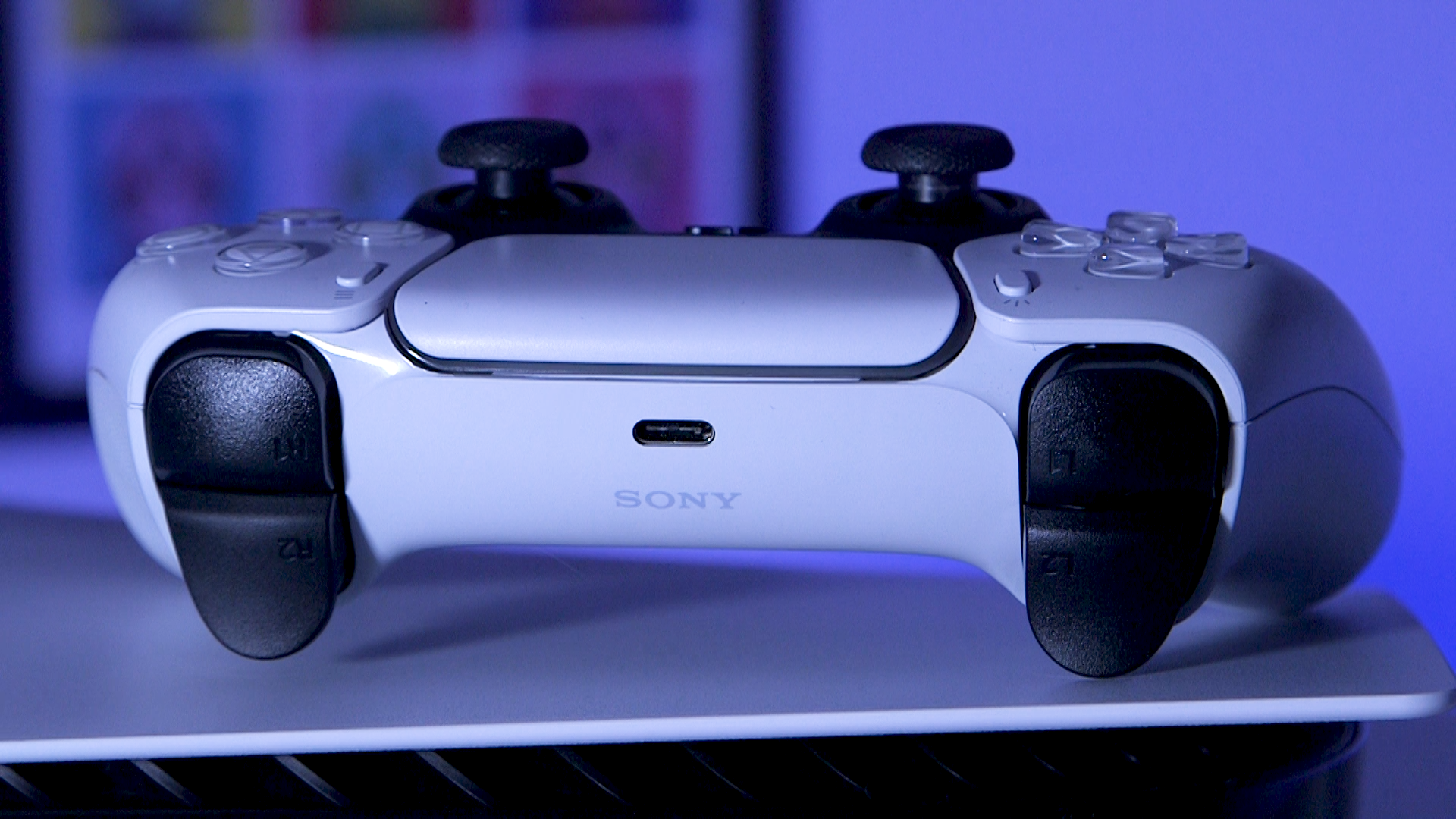
PS5 review: features
- Redesigned user interface with beautiful splash screens for every game
- PlayStation button has all new features
- Party chat allows you to screen share
Design is one thing, but what can really elevate a console to the next level is its feature set – and thankfully the PS5 delivers here.
The PS5 innovates on what Sony's consoles have done in the past and, as a result, it might take a minute or two to get used to some of the new controls – pressing and holding the PlayStation button on the controller no longer brings up the quick menu, for example, but instead brings up a new Control Center.
This operates in much the same way as the quick menu did, and lets you view various sub-menus such as your Friends list, downloads in progress, notifications and, if you have your account linked, Spotify.
One of the more prominent new features is the PS5's Cards, with the most impactful being Activity Cards. Cards have various functions, allowing you to track trophy progress, jump into specific parts of a game like a challenge or multiplayer mode, see how far along you are on a game level, or simply see news from a developer. You can even watch a livestream of your friend’s gameplay using a picture-in-picture mode, which is pretty cool.
Cards are also present as you delve further into a game’s information, which is now displayed beautifully on the home screen.
By pressing down on the D-pad or flicking down on the analog stick, you can see the available Cards at a glance, circumventing the need to visit a game's main menu or particular mode to find out what's going on. They should prove useful for gamers of a lesser ability, too, as they can contain in-game hint videos in supported titles that help you overcome specific challenges or find that one last collectible.
Since launch, we've already seen Sony retiring this PS5 launch feature, Accolades. Designed as a community awards feature to lets players commend fellow gamers for their assistance, Sony revealed that it hasn't received much use as anticipated, so it's now been dropped.

Overall, we found Cards to be a useful addition, though horizontally scrolling through each one did feel cumbersome at times.
There's also a slight delay before they appear, which is at odds with the speed of the system as a whole. But, while not essential by any means, they help to add another layer of next-gen gloss to PlayStation 5 experience that you won’t find anywhere else.
Outside of the interface, you can expect the return of groups and other social-based features from the PS4, like SharePlay, as well as easy video sharing. You'll be able to jump straight into the game your friends are playing from the menu, or invite them to larger groups. Video sharing on the PS5 works similarly to how it did on the PS4, but it's nice to be able to see a preview in Cards.
Speaking of social features, if you're tired of typing out messages using a D-pad or analog stick, the PS5 also supports voice dictation for messaging thanks to the DualSense controller's built-in mic. You can also use PS5 voice commands to open games, apps and put the console in Rest Mode.
While your mileage may vary when it comes to the accuracy of the dictation (as with all voice recognition software), it could prove handy when you need to fire off a quick message to a friend. We did find it to be inconsistent in our testing, though, and not as accurate as something like Google Assistant.
We also like the fact you can choose system-wide settings for certain aspects on PS5 such as your preferred difficulty level or whether you invert the x or y-axis on your controller during games. You can even choose which graphical mode you prefer games to automatically select: performance or resolution.
PS5: streaming video services and other apps
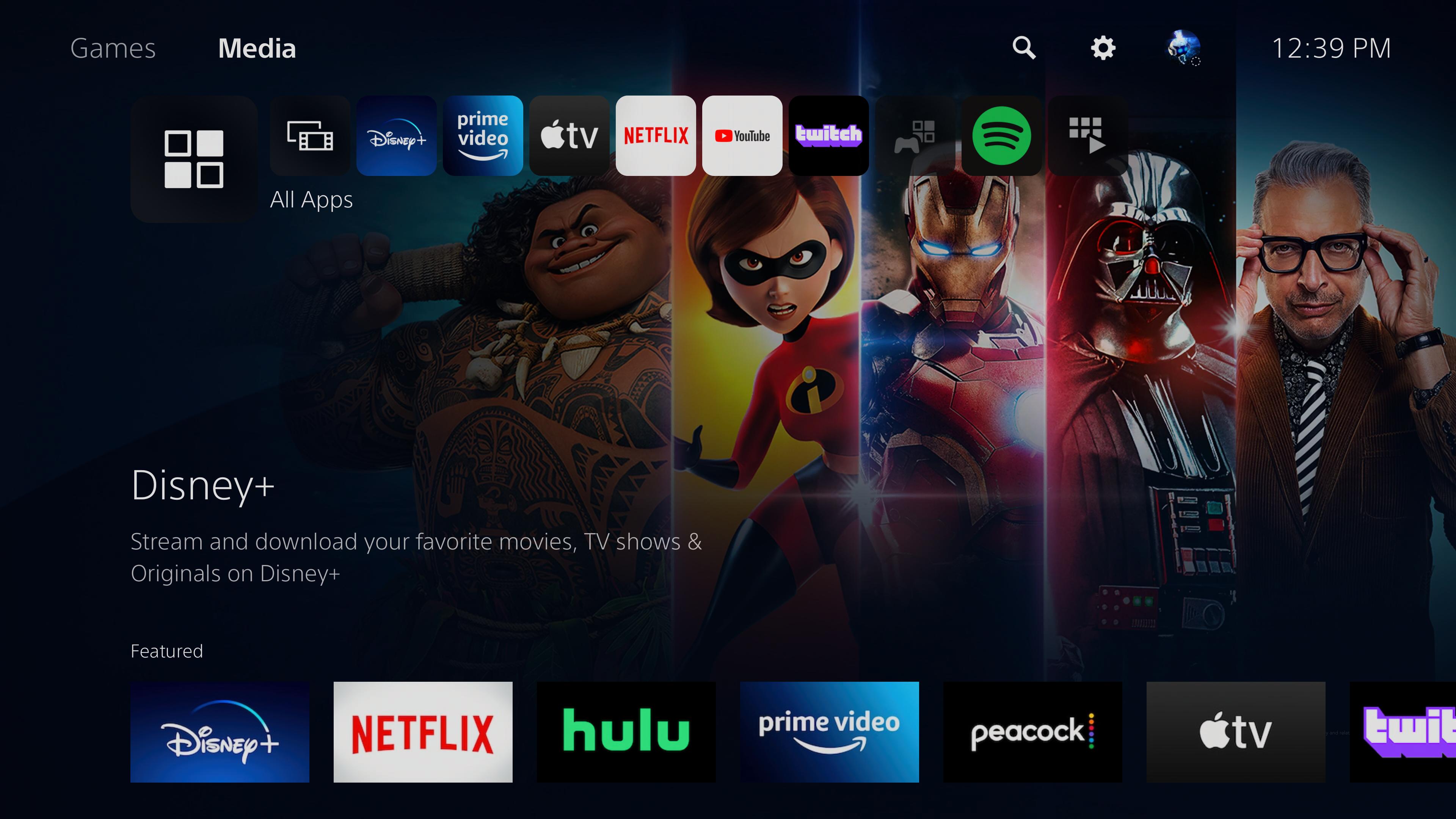
Of course, game consoles can do more than just provide your thumbs with something to do - modern consoles are also full-on streaming video players.
Right now, you'll find over a dozen supported streaming services on the PS5 including most major services like Netflix, Disney Plus, Amazon Prime Video, Hulu, Peacock and Apple TV, as well as a few more niche services like Twitch, NFL Sunday Ticket, ESPN, Vudu, Tubi, WWE Network and Crunchyroll. The selection here isn't as big as you'd find on, say, a Roku streaming player, but it should be enough for most.
The worse news is that, as it stands, there's no support anywhere on the console Dolby Vision. We thought we might it them appear on launch day, but it never materialized. Support was later added for Dolby Atmos, however.
What that means, unfortunately, is that the PS5 is really only a middling media player - it can't best dedicated streamers like the Nvidia Shield, Amazon Fire TV Cube, Apple TV 4K or the new Roku Ultra, and isn't the console we'd recommend to our cinephile friends looking to host movie night with the highest fidelity films.
PS5 review: game library
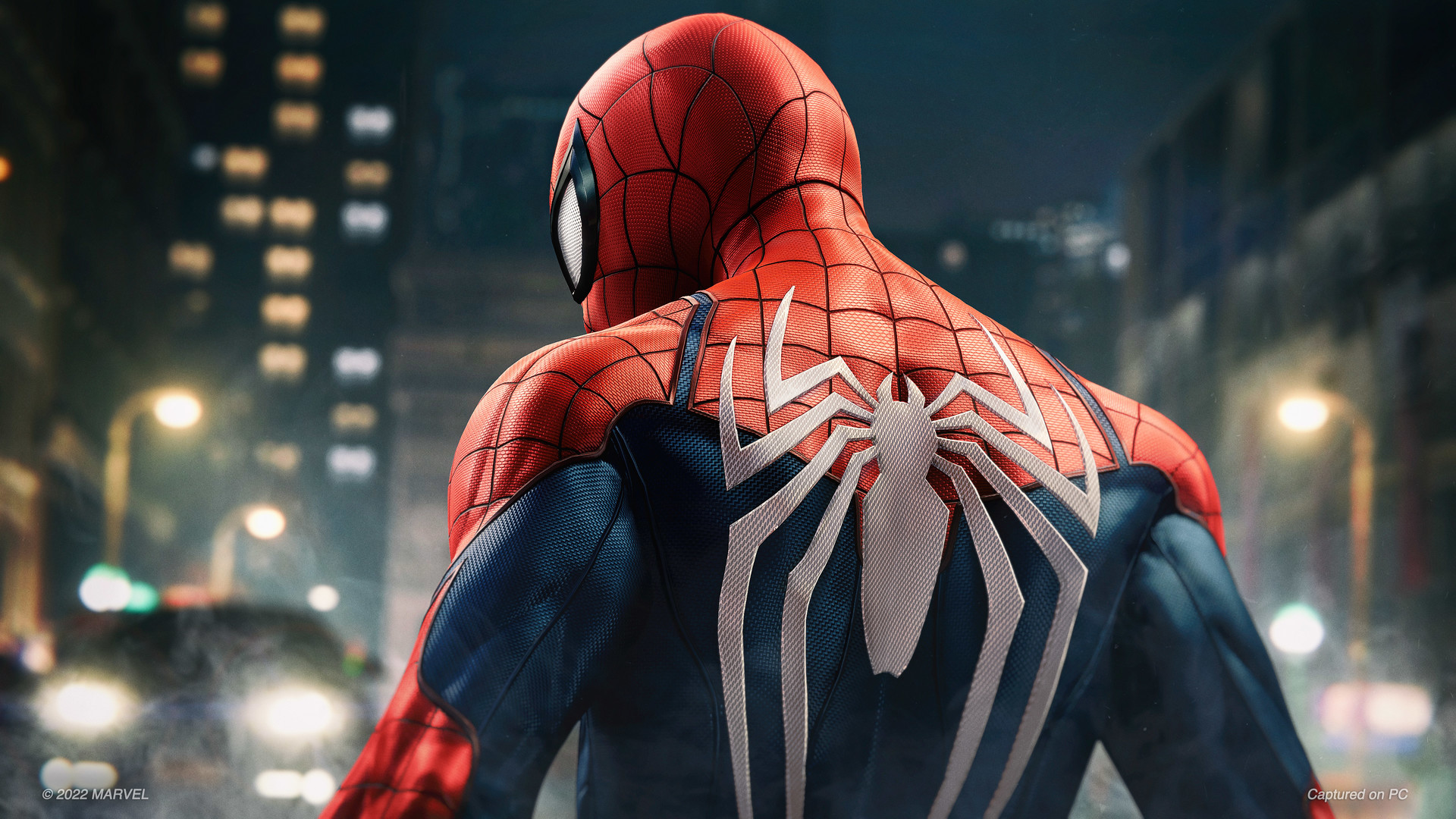
- Every PS5 comes with Astro’s Playroom installed
- PlayStation Plus Collection is a great introduction to new players
- Limited backwards compatibility with PS3, PS2 and PS One games
Most consoles don't launch with a full library of games right off the bat, so the launch bar was pretty low for the PS5. That being said, what you make of the PlayStation 5's current game library largely depends on if you finished the masterpieces from the PS4's era – games like God of War, The Last of Us Part 2, Marvel's Spider-Man, and Uncharted 4: A Thief's End.
If you haven't finished them, or haven't played them at all, you could have over a dozen excellent games to play from the second you turn on the PS5 via backwards compatibility, a number of which have been improved thanks to a 60fps update, like Ghost of Tsushima and Days Gone.
If you have PS Plus, you might also have access to some older games that passed you by. Every PS5 comes pre-installed with Astro's Playroom, too, and it's a thrilling showcase for what the system can do.

A fully fleshed-out sequel to Astro Bot: Rescue Mission, Astro's Playroom is a platformer that features exotic locales in which are hidden artifacts from Sony's PlayStation hardware catalog. You'll find a PlayStation VR Aim Controller hidden in a snowbank somewhere in one level, for example, while another level might contain a PlayStation Portable for you to discover.
It's a nice homage to the PlayStation hardware that's come and gone, but we expect some folks will play through it, then uninstall it to reclaim the 10GB of storage space it takes up on the console. You can always re-download it from your games library or the PlayStation Store should you wish to play it again.
But what else is there to play if you pick up a PS5 today? Well, the PS5 library mostly consists of cross-generation titles at the moment and is helped greatly by the fact it’s fully backward compatible with PS4.
However, the list of noteworthy PS5 games is growing and includes some first-party heavy hitters like Sackboy: A Big Adventure, Demon’s Souls, The Last of Us: Part 1, God of War Ragnarok, Horizon Forbidden West, Returnal, and Gran Turismo 7. You can also pick up some big third-party games like Resident Evil Village, Stray, Saints Row, Elden Ring, and Assassin's Creed Valhalla.
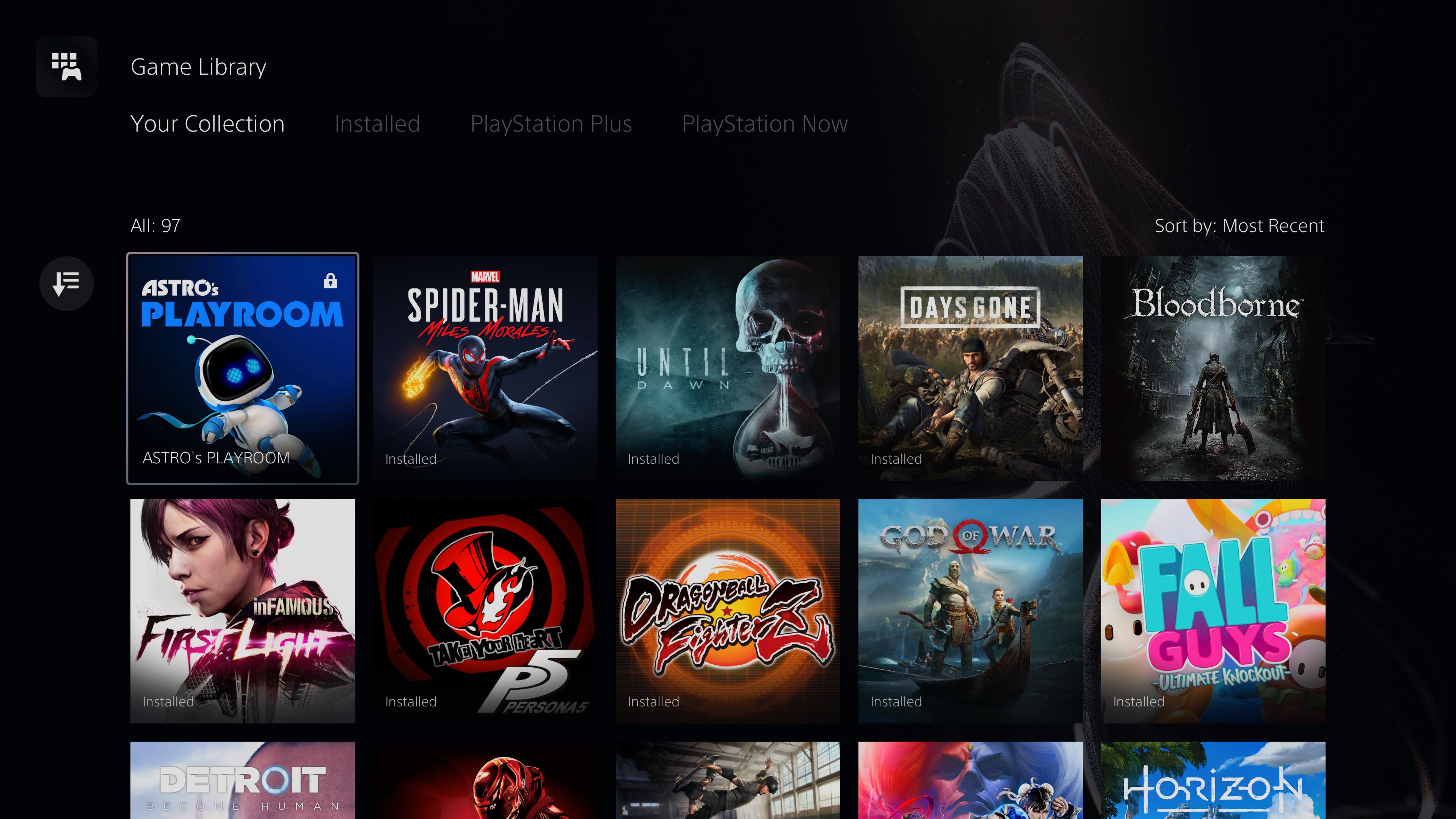
There are also various independent games that are worth a shout, like the indie charmer Bugsnax (that one with the infuriatingly catchy theme tune), which was available as the console's first PlayStation Plus downloadable game.
We'll continue to keep an eye out for the best PS5 games as the console matures and you can keep track of all the new PS5 games on the way.
PS5: backward compatibility

What about folks who want to play older games? Well, the PlayStation 5 can play almost any PS4 game but not everything is compatible, though the incompatible games list is miniscule. There's no way to pop in a PS3 disc and have it work or transfer over your PlayStation Classics purchases you made on the PS Vita a few years ago.
We're as disappointed as you are with the lack of backward-compatibility support for Sony’s previous generation of games, particularly as Xbox 360 and original Xbox games (physical discs included) work on the Xbox Series X, but it's not uncommon for a new console to only support the last generation of games as manufacturers look to the future.
It used to be that you could choose select PS3/PS2 titles via PlayStation Now… but that's been replaced with a revamped PS Plus service, which also includes PS1 and PSP games. Accessing your old PS4 games is thankfully a cinch on Sony's new system, though. Simply select the Library icon and the PS5 will automatically pull in all your digital purchases and previously installed games, providing you're signed in to your PlayStation Network account.
You'll need to redownload them to the console, of course, or insert the physical disc to activate a game's license. Some games have been upgraded to run better than ever on PS5, too, like Days Gone, which now runs at a silky-smooth 60fps, while God of War can now comfortably hit its 60 frames per second target using the game’s performance mode.
One thing to note is that you may notice your save file is missing when you boot up a PS4 game that you previously owned for the first time – that's because you'll need to redownload your save files from the cloud onto your PS5 console first. Here's how to transfer PS4 save data to PS5.
PS Plus members have access to cloud saves, but if you haven't been backing up your save files over the air, then you may notice your data won’t be there initially. It's not the most seamless system, admittedly, and is bound to confuse some users, but support for carrying over your save files appears to be there for most of the older titles we tested – however, this will vary on a case by case basis.
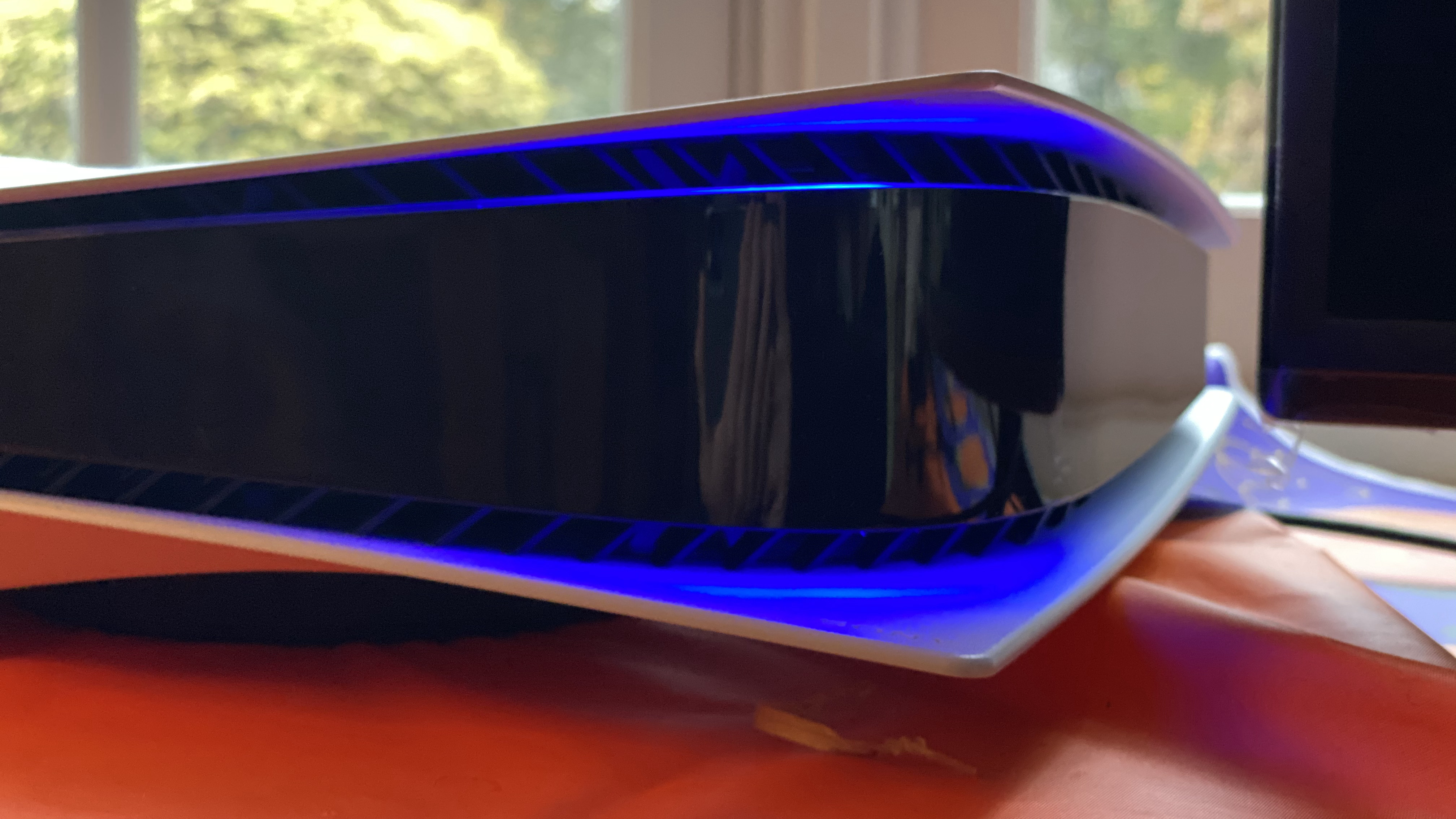
Should I buy the PS5?
Buy it if...
You plan on buying a new game console in the next six months
The PS5 is a seriously great next-gen gaming console – and one we’ll be recommending to our friends and families for a while yet. The new controller is revolutionary, and the whole experience feels fresh, fast, and satisfying to use.
You want a taste of current-gen without losing your PS4 games
One of the best things about the PlayStation 5 is that it acts as a bridge between generations. Your entire library of digital PS4 games is there from the moment you log into your PSN account, and any great games you missed will likely be part of the PlayStation Plus Collection.
You're tired of loading screens and ready for higher frame rates
The marquee features of the PS5 are its SSD, which significantly reduces the time it takes for games to start up, and its cutting-edge GPU, which enables ray-traced graphics and resolutions up to 4K at 120fps – and, possibly, all the way up to 8K/60fps in the future.
Don't buy if...
You're looking for a great Dolby Vision Blu-ray player
If you're a home media enthusiast who has a collection of 4K Dolby Vision Blu-rays at home and a Dolby Atmos speaker system, you probably won't love the PS5. Yes, it will be able to play 4K Blu-Ray discs, but because it doesn't support Dolby Vision's cutting-edge format, we won't be recommending it to the audiovisual community.
You want to play loads of native PS5 games
The PS5's exclusive game catalog is growing, but still a little on the small side. That doesn't mean things won't improve; they most certainly will, but as it stands, don't expect to be overwhelmed with options.
Your home console setup is cramped already
It might not be an issue for some, but it's worth calling attention to how big the original PS5 is one last time. If you're short on space, and you physically don't have room for a gargantuan console on your entertainment center or desk, then you might want to hold off, but this has been somewhat addressed with the slimmer, updated PS5 model.
Also consider...
Xbox Series X
Microsoft's flagship console is a great alternative to the PS5 if you prefer games like Halo Infinite and Forza. It also offers unique features such as Quick Resume that lets you flick between several games at a time without having to close them.
Xbox Series S
The smallest Xbox ever made, if you're looking for a gateway into next-gen gaming, the Xbox Series S offers excellent performance for an affordable price. Make sure you pick up Xbox Game Pass, too.
Nintendo Switch OLED
Nintendo's latest iteration of the Switch is the best one yet. With a gorgeous OLED screen, redesigned kickstand and speakers, the Switch OLED is the perfect second system. You can also play it anywhere, anytime.
First reviewed: November 2020.
How we test
We pride ourselves on our independence and our rigorous review-testing process, offering up long-term attention to the products we review and making sure our reviews are updated and maintained - regardless of when a device was released, if you can still buy it, it's on our radar.
Adam was formerly TRG's Hardware Editor. A law graduate with an exceptional track record in content creation and online engagement, Adam has penned scintillating copy for various technology sites and also established his very own award-nominated video games website. He’s previously worked at Nintendo of Europe as a Content Marketing Editor and once played Halo 5: Guardians for over 51 hours for charity. He is now an editor at The Shortcut.
- Henry Stockdale
- Catherine LewisNews Writer, TechRadar Gaming
- Nick Pino
- Kara PhillipsEvergreen Writer
- Rhys WoodHardware Editor
